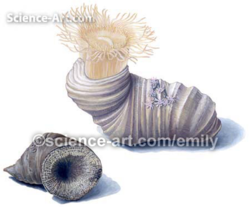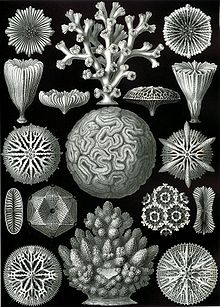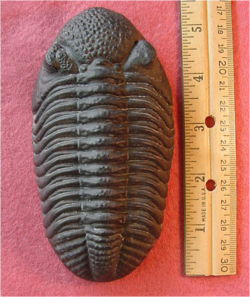Difference between revisions of "Fossils/Invertebrates"
Jump to navigation
Jump to search
| Line 8: | Line 8: | ||
|Range= Precambrian to Recent. Sponges reached their greatest diversity during the Cretaceous period. | |Range= Precambrian to Recent. Sponges reached their greatest diversity during the Cretaceous period. | ||
|Tax= Kingdom Animalia. | |Tax= Kingdom Animalia. | ||
| − | |Mode= They are benthic and sessile, and live in marine and freshwater environments. | + | |Mode= They are benthic and sessile, and live in marine and freshwater environments. Sponges are free-swimming in their larval stages. Sponges can have a symbiotic relationship with blue-green algae (shallow sponges are more likely to do this). Sponges can be reef builders, being able to house organisms such as nematodes, crustaceans and mollusks in the osculum (center chamber). |
|Adapt= They were the first to branch off from the common ancestor of all animals, so they're the sister group of all other animals. The shapes of their bodies are adapted for maximal efficiency of water flow through the central cavity. Some specimens can move at around 1-4 mm a day. | |Adapt= They were the first to branch off from the common ancestor of all animals, so they're the sister group of all other animals. The shapes of their bodies are adapted for maximal efficiency of water flow through the central cavity. Some specimens can move at around 1-4 mm a day. | ||
|Distr= Sponges are worldwide in their distribution, living in a wide range of ocean habitats. | |Distr= Sponges are worldwide in their distribution, living in a wide range of ocean habitats. | ||
Revision as of 17:30, 16 October 2020
- Main article: Fossils
This page is incomplete. |
Sponges (Phylum Porifera)
Genus Astraeospongia (calcareous sponge)
Genus Hydnoceras (glass sponge)
Bryozoans (Phylum Bryozoa)
Graptolites (Phylum Hemichordata)
Order Dendroidea (benthic graptolites)
Order Graptoloidea (planktic graptolites)
Corals (Phylum Cnidaria)
Order Tabulata (tabulate corals)
Order Rugosa (rugose corals)
Order Scleratinia (stony corals)
Arthropods (Phylum Arthropoda)
Class Insecta (Insects)
Class Trilobita (Trilobites)
Brachiopods (Phylum Brachiopoda)
Class Inarticulata
| Picture(s) | No pictures have been added as of yet. |
|---|---|
| Physical Description | Most inarticulate brachiopods are less than 1 cm in size - smaller than articulate brachiopods. Their shells were composed of calcium phosphate. They lack the tooth and socket arrangement between the valves that is present in articulate brachiopods. |
| Fossil Range | Cambrian - recent. |
| Mode of Life or Habitat | Although they were originally shallow marine organisms, today's brachiopods are only found in the deep ocean. They could be either epifaunal or infaunal in nature, depending on the species. They were filter feeders. |
| Distribution | Worldwide |
Class Articulata
Order Rhynchonellida
Mollusks (Phylum Mollusca)
| Picture(s) | No pictures have been added as of yet. |
|---|
Class Bivalvia (clams, oysters, mussels)
| Picture(s) | No pictures have been added as of yet. |
|---|---|
| Physical Description | Bivalves are a still living class of mollusks that include oysters, clams, mussels, and scallops. Their shells are either made of aragonite or calcite. They are usually bilaterally symmetrical. They may look superficially like brachiopods. |
| Fossil Range | Early Cambrian - Recent. The first freshwater bivalves appeared in the Devonian. |
| Mode of Life or Habitat | Mostly marine - some live in lakes and streams. Many bivalves burrow into the sediment. Bivalves can be shallow infaunal, deep infaunal, or epifaunal. |
| Additional Information | "Bivalvia" means "two valves." |
| Picture(s) | No pictures have been added as of yet. |
|---|---|
| Common Names | Bittersweet Clam |
| Physical Description | They have medium-sized thick aragonite shells which are almost circular. The surface is either smooth or radially ribbed. The hinge is heavy, with a row of 6-12 teeth. |
| Fossil Range | Early Cretaceous to recent. They reached maximum diversity in the Cretaceous. |
| Mode of Life or Habitat | They burrow into the sand and mud in shallow waters. |
| Adaptations Over Time | They evolved convergently with genus Composita. |
| Distribution | Worldwide. Today, they are common in North Carolina. |
| Additional Information | This genus was named by Carl Linnaeus in 1758. |
| Picture(s) | No pictures have been added as of yet. |
|---|---|
| Physical Description | 1 to 3 inches. They had annual growth lines. |
| Mode of Life or Habitat | Marine - mainly temperate, shallow water. They were benthic suspension feeders. |
| Distribution | Worldwide, mainly Northern Hemisphere. |
| Additional Information | Named after the goddess Astarte, a goddess of war and sexual love in the modern Middle East. |
| Picture(s) | No pictures have been added as of yet. |
|---|---|
| Physical Description | Shells grew up to 30 mm. They were approximately triangular in shape. The surface had fine cocentric growth lines. |
| Fossil Range | Ordovician - recent. |
| Mode of Life or Habitat | Shallow seas in the muddy sand close to the sediment surface. They are benthic selective deposit feeders, feeding on a variety of microzooplankton, organic matter, and microbes. |
| Distribution | Worldwide. |
| Additional Information | "Nucula" comes from Latin. |
Class Cephalopoda
| Picture(s) | No pictures have been added as of yet. |
|---|
Order Goniatitida (goniatites)
| Picture(s) | No pictures have been added as of yet. |
|---|
Order Ceratitida (ceratites)
| Picture(s) | No pictures have been added as of yet. |
|---|
Order Ammonitida (ammonites)
Order Belemnitida (Belemnites)
| Picture(s) | No pictures have been added as of yet. |
|---|
Order Nautilida (Chambered Nautilus)
| Picture(s) | 
|
|---|
Order Orthocerida ("Orthoceras")
Class Gastropoda (Snails)
| Picture(s) | No pictures have been added as of yet. |
|---|
| Picture(s) | 
|
|---|---|
| Additional Information | Platyceras is a gastrophod ranging from the Silurian to the Middle Triassic. They fed off of crinoid excrement. |
| Picture(s) | 
|
|---|---|
| Additional Information | Worthenia was a gastropod that lived from the Devonian to the Triassic. It was named after the paleontologist Amos Henry Worthen. |
Echinoderms (Phylum Echinodermata)
| Picture(s) | No pictures have been added as of yet. |
|---|
Class Asteroidea (Starfish)
| Picture(s) | No pictures have been added as of yet. |
|---|
Class Blastoidea
| Picture(s) | No pictures have been added as of yet. |
|---|
| Picture(s) | No pictures have been added as of yet. |
|---|
Class Crinoidea
| Picture(s) | No pictures have been added as of yet. |
|---|---|
| Additional Information | Competitors are required to identify the stems, columns and calyxes of crinoids for this event. |
Class Echinoidea
| Picture(s) | No pictures have been added as of yet. |
|---|---|
| Additional Information | Competitors are required to identify both regular and irregular echinoids, such as sea urchins and sand dollars. |
Class Ophiuroidea (brittle stars)
| Picture(s) | No pictures have been added as of yet. |
|---|























































